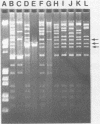Abstract
Yersinia pseudotuberculosis was isolated from retail pork and from healthy swine throats. These wild-type strains and their representative cured isogenic strains were tested for the presence of plasmids and several virulence factors, and these characteristics were compared with those of virulent strains from humans. Two pork isolates (serotype IVB) and four swine isolates (serotypes IIB, IIC, III, and IVB) harbored a 42- to 48-megadalton plasmid which had similar fragmentation patterns resulting from digestion with restriction endonuclease. These six strains were lethal for mice via oral challenge and were positive in autoagglutination and calcium dependency tests. They also invaded HeLa cells and induced cytotoxicity. Histopathological examination and indirect fluorescent-antibody staining provided definite evidence of the pathogenicity of these strains when tissue sections from orally infected mice were used. The virulence factors of wild-type pork and swine isolates with the 42- to 48-megadalton plasmid were identical to those of two human isolates (serotypes IVB and VB). Hence, these pork and swine isolates should be considered potentially pathogenic for humans. The finding suggests that retail pork and swine may play an important role in the epidemiology of human infections caused by Y. pseudotuberculosis.
Full text
PDF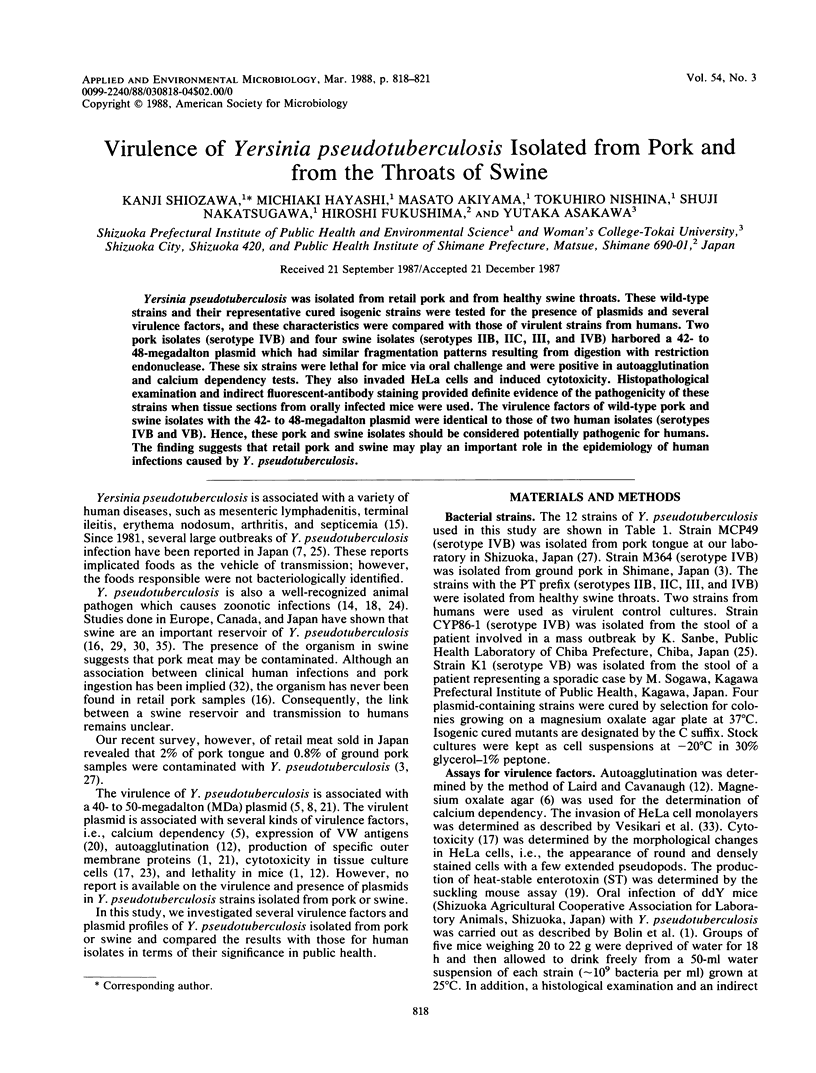
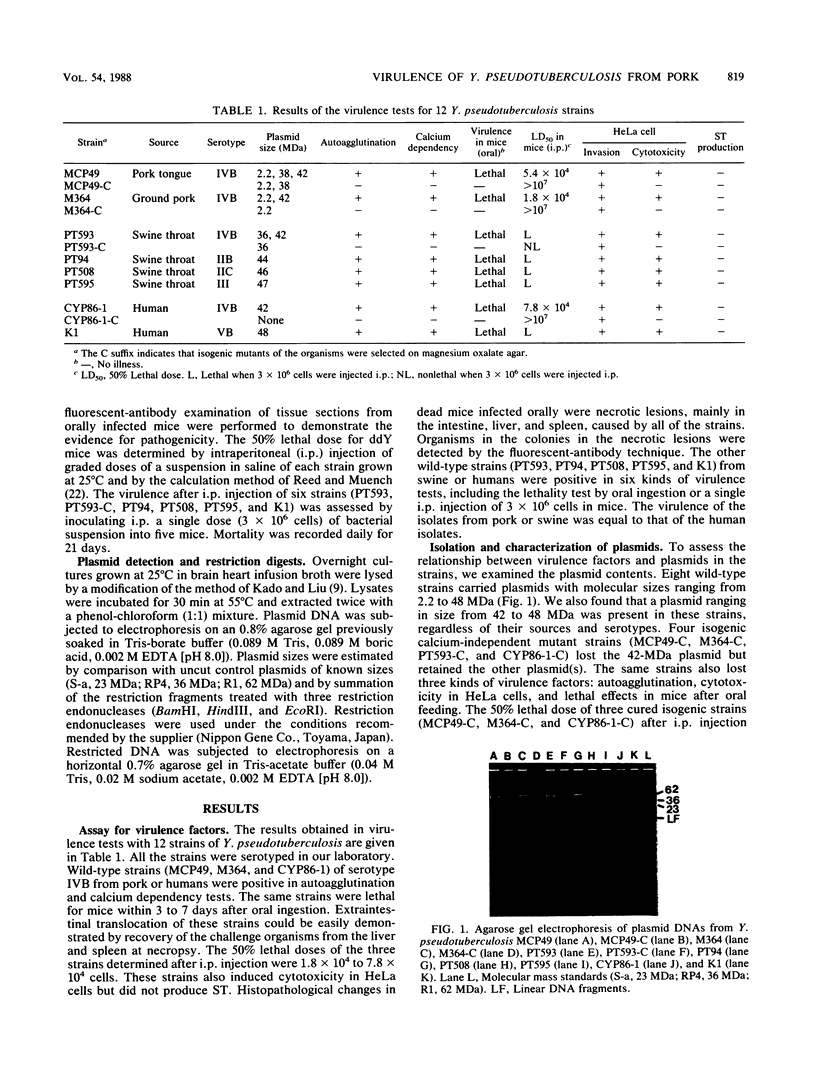
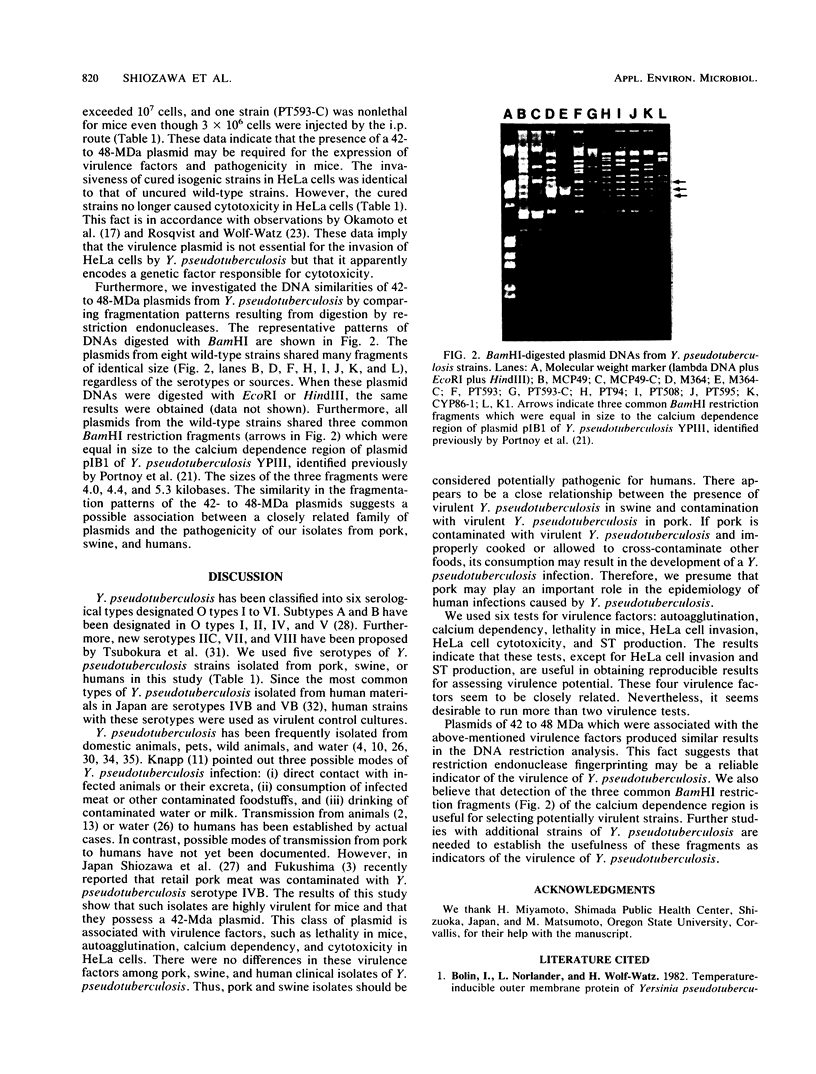
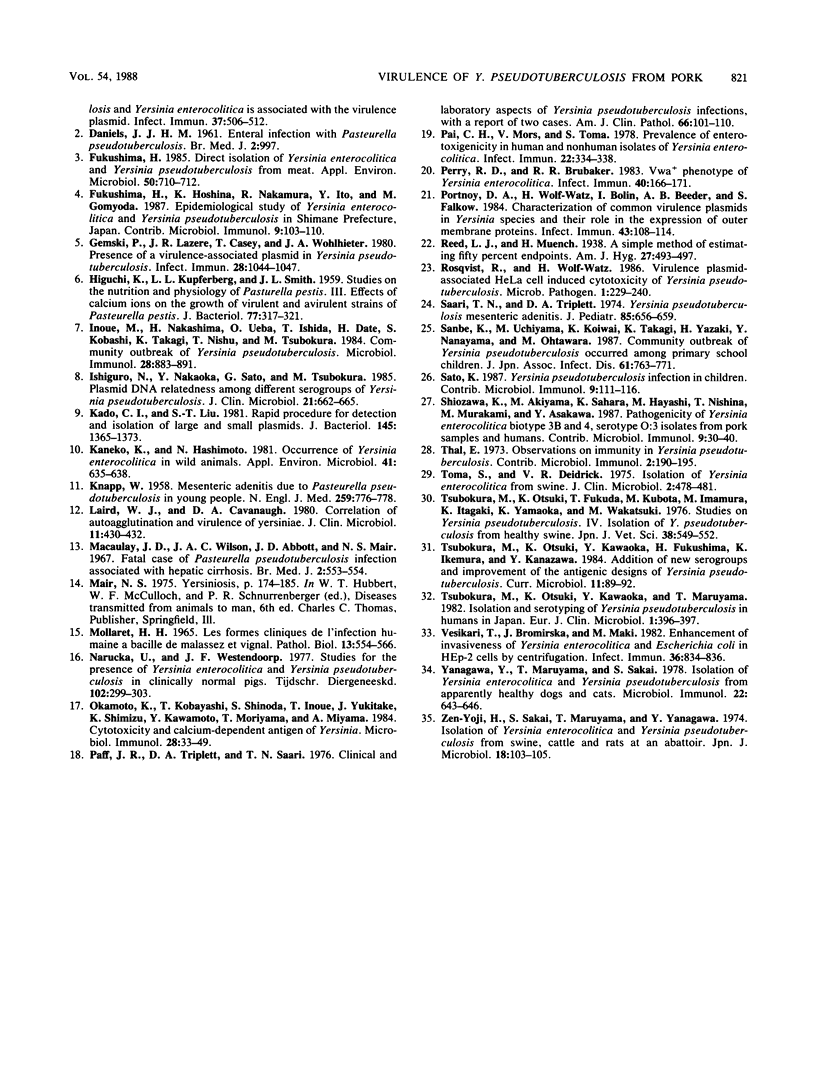
Images in this article
Selected References
These references are in PubMed. This may not be the complete list of references from this article.
- Bölin I., Norlander L., Wolf-Watz H. Temperature-inducible outer membrane protein of Yersinia pseudotuberculosis and Yersinia enterocolitica is associated with the virulence plasmid. Infect Immun. 1982 Aug;37(2):506–512. doi: 10.1128/iai.37.2.506-512.1982. [DOI] [PMC free article] [PubMed] [Google Scholar]
- DANIELS J. J. Enteral infection with Pasteurella pseudotuberculosis. Br Med J. 1961 Oct 14;2(5258):997–997. doi: 10.1136/bmj.2.5258.997. [DOI] [PMC free article] [PubMed] [Google Scholar]
- Fukushima H. Direct isolation of Yersinia enterocolitica and Yersinia pseudotuberculosis from meat. Appl Environ Microbiol. 1985 Sep;50(3):710–712. doi: 10.1128/aem.50.3.710-712.1985. [DOI] [PMC free article] [PubMed] [Google Scholar]
- Fukushima H., Hoshina K., Nakamura R., Ito Y., Gomyoda M. Epidemiological study of Yersinia enterocolitica and Yersinia pseudotuberculosis in Shimane Prefecture, Japan. Contrib Microbiol Immunol. 1987;9:103–110. [PubMed] [Google Scholar]
- Gemski P., Lazere J. R., Casey T., Wohlhieter J. A. Presence of a virulence-associated plasmid in Yersinia pseudotuberculosis. Infect Immun. 1980 Jun;28(3):1044–1047. doi: 10.1128/iai.28.3.1044-1047.1980. [DOI] [PMC free article] [PubMed] [Google Scholar]
- HIGUCHI K., KUPFERBERG L. L., SMITH J. L. Studies on the nutrition and physiology of Pasteurella pestis. III. Effects of calcium ions on the growth of virulent and avirulent strains of Pasteurella pestis. J Bacteriol. 1959 Mar;77(3):317–321. doi: 10.1128/jb.77.3.317-321.1959. [DOI] [PMC free article] [PubMed] [Google Scholar]
- Inoue M., Nakashima H., Ueba O., Ishida T., Date H., Kobashi S., Takagi K., Nishu T., Tsubokura M. Community outbreak of Yersinia pseudotuberculosis. Microbiol Immunol. 1984;28(8):883–891. doi: 10.1111/j.1348-0421.1984.tb00744.x. [DOI] [PubMed] [Google Scholar]
- Ishiguro N., Nakaoka Y., Sato G., Tsubokura M. Plasmid DNA relatedness among different serogroups of Yersinia pseudotuberculosis. J Clin Microbiol. 1985 Apr;21(4):662–665. doi: 10.1128/jcm.21.4.662-665.1985. [DOI] [PMC free article] [PubMed] [Google Scholar]
- KNAPP W. Mesenteric adenitis due to Pasteurella pseudotuberculosis in young people. N Engl J Med. 1958 Oct 16;259(16):776–778. doi: 10.1056/NEJM195810162591606. [DOI] [PubMed] [Google Scholar]
- Kado C. I., Liu S. T. Rapid procedure for detection and isolation of large and small plasmids. J Bacteriol. 1981 Mar;145(3):1365–1373. doi: 10.1128/jb.145.3.1365-1373.1981. [DOI] [PMC free article] [PubMed] [Google Scholar]
- Kaneko K., Hashimoto N. Occurrence of Yersinia enterocolitica in wild animals. Appl Environ Microbiol. 1981 Mar;41(3):635–638. doi: 10.1128/aem.41.3.635-638.1981. [DOI] [PMC free article] [PubMed] [Google Scholar]
- Laird W. J., Cavanaugh D. C. Correlation of autoagglutination and virulence of yersiniae. J Clin Microbiol. 1980 Apr;11(4):430–432. doi: 10.1128/jcm.11.4.430-432.1980. [DOI] [PMC free article] [PubMed] [Google Scholar]
- Macaulay J. D., Wilson J. A., Abbott J. D., Mair N. S. Fatal case of Pasteurella pseudotuberculosis infection associated with hepatic cirrhosis. Br Med J. 1967 May 27;2(5551):553–554. doi: 10.1136/bmj.2.5551.553. [DOI] [PMC free article] [PubMed] [Google Scholar]
- Mollaret H. H. Les formes cliniques de l'infection humaine à bacille de Malassez et Vignal. Pathol Biol. 1965 May;13(9):554–566. [PubMed] [Google Scholar]
- Narucka U., Westendoorp J. F. Een onderzoek naar het voorkomen van Yersinia enterocolitica en Yersinia pseudotuberculosis bij klinisch normale varkens. Tijdschr Diergeneeskd. 1977 Mar 1;102(5):299–303. [PubMed] [Google Scholar]
- Okamoto K., Kobayashi T., Shinoda S., Inoue T., Yukitake J., Shimizu K., Kawamoto Y., Moriyama T., Miyama A. Cytotoxicity and calcium-dependent antigen of Yersinia. Microbiol Immunol. 1984;28(1):33–49. doi: 10.1111/j.1348-0421.1984.tb02945.x. [DOI] [PubMed] [Google Scholar]
- Paff J. R., Triplett D. A., Saari T. N. Clinical and laboratory aspects of Yersinia pseudotuberculosis infections, with a report of two cases. Am J Clin Pathol. 1976 Jul;66(1):101–110. doi: 10.1093/ajcp/66.1.101. [DOI] [PubMed] [Google Scholar]
- Pai C. H., Mors V., Toma S. Prevalence of enterotoxigenicity in human and nonhuman isolates of Yersinia enterocolitica. Infect Immun. 1978 Nov;22(2):334–338. doi: 10.1128/iai.22.2.334-338.1978. [DOI] [PMC free article] [PubMed] [Google Scholar]
- Perry R. D., Brubaker R. R. Vwa+ phenotype of Yersinia enterocolitica. Infect Immun. 1983 Apr;40(1):166–171. doi: 10.1128/iai.40.1.166-171.1983. [DOI] [PMC free article] [PubMed] [Google Scholar]
- Portnoy D. A., Wolf-Watz H., Bolin I., Beeder A. B., Falkow S. Characterization of common virulence plasmids in Yersinia species and their role in the expression of outer membrane proteins. Infect Immun. 1984 Jan;43(1):108–114. doi: 10.1128/iai.43.1.108-114.1984. [DOI] [PMC free article] [PubMed] [Google Scholar]
- Rosqvist R., Wolf-Watz H. Virulence plasmid-associated HeLa cell induced cytotoxicity of Yersinia pseudotuberculosis. Microb Pathog. 1986 Jun;1(3):229–240. doi: 10.1016/0882-4010(86)90047-1. [DOI] [PubMed] [Google Scholar]
- Saari T. N., Triplett D. A. Yersinia pseudotuberculosis mesenteric adenitis. J Pediatr. 1974 Nov;85(5):656–659. doi: 10.1016/s0022-3476(74)80509-3. [DOI] [PubMed] [Google Scholar]
- Sanbe K., Uchimura M., Koiwai K., Takagi K., Yazaki H., Nanayama Y., Ohtawara M. [Community outbreak of Yersinia pseudotuberculosis occurred among primary school children]. Kansenshogaku Zasshi. 1987 Jul;61(7):763–771. doi: 10.11150/kansenshogakuzasshi1970.61.763. [DOI] [PubMed] [Google Scholar]
- Sato K. Yersinia pseudotuberculosis infection in children. Clinical manifestations and epidemiology. Contrib Microbiol Immunol. 1987;9:111–116. [PubMed] [Google Scholar]
- Shiozawa K., Akiyama M., Sahara K., Hayashi M., Nishina T., Murakami M., Asakawa Y. Pathogenicity of Yersinia enterocolitica biotype 3B and 4, serotype 0:3 isolates from pork samples and humans. Contrib Microbiol Immunol. 1987;9:30–40. [PubMed] [Google Scholar]
- Toma S., Deidrick V. R. Isolation of Yersinia enterocolitica from swine. J Clin Microbiol. 1975 Dec;2(6):478–481. doi: 10.1128/jcm.2.6.478-481.1975. [DOI] [PMC free article] [PubMed] [Google Scholar]
- Tsubokura M., Otsuki K., Fukuda T., Kubota M., Imamura M. Studies on Yersinia pseudotuberculosis. IV. Isolation of Y. pseudotuberculosis from healthy swine. Nihon Juigaku Zasshi. 1976 Dec;38(6):549–552. doi: 10.1292/jvms1939.38.549. [DOI] [PubMed] [Google Scholar]
- Tsubokura M., Otsuki K., Kawaoka Y., Maruyama T. Isolation and serotyping of Yersinia pseudotuberculosis in humans in Japan. Eur J Clin Microbiol. 1982 Dec;1(6):396–397. doi: 10.1007/BF02019942. [DOI] [PubMed] [Google Scholar]
- Vesikari T., Bromirska J., Mäki M. Enhancement of invasiveness of Yersinia enterocolitica and Escherichia coli in HEp-2 cells by centrifugation. Infect Immun. 1982 May;36(2):834–836. doi: 10.1128/iai.36.2.834-836.1982. [DOI] [PMC free article] [PubMed] [Google Scholar]
- Yanagawa Y., Maruyama T., Sakai S. Isolation of Yersinia enterocolitica and Yersina pseudotuberculosis from apparently healthy dogs and cats. Microbiol Immunol. 1978;22(10):643–646. doi: 10.1111/j.1348-0421.1978.tb00415.x. [DOI] [PubMed] [Google Scholar]
- Zen-Yoji H., Sakai S., Maruyama T., Yanagawa Y. Isolation of Yersinia enterocolitica and Yersinia pseudotuberculosis from swine, cattle and rats at an abattoir. Jpn J Microbiol. 1974 Jan;18(1):103–105. doi: 10.1111/j.1348-0421.1974.tb00753.x. [DOI] [PubMed] [Google Scholar]




